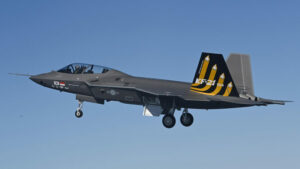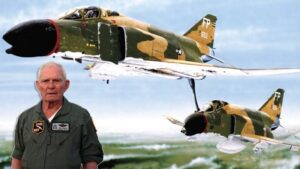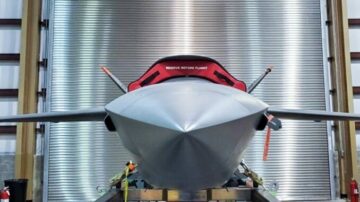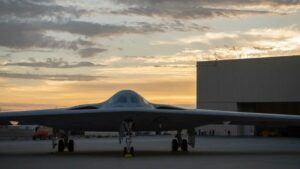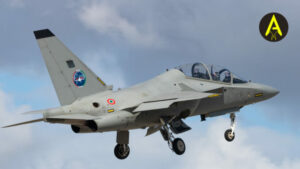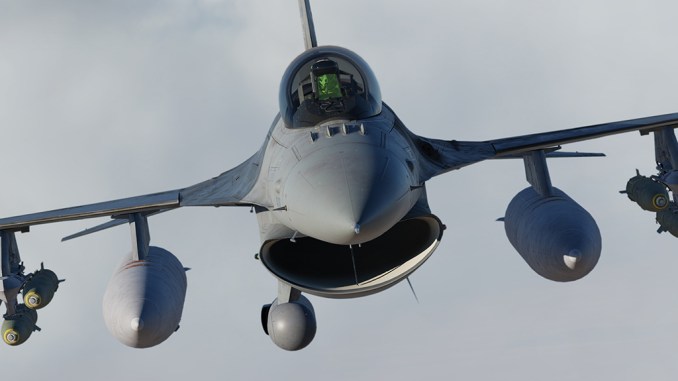
Among all videogames featuring the Viper, Falcon BMS and DCS World are the most accurate representations of the F-16, a civilian can get his/her hands on.
The F-16 is one of the world’s most popular and most recognizable fighter jets, so it is not surprising if the Viper, as it is nicknamed by its crews, can be found in all modern air combat videogames. Two of them, however, take the lead as the most realistic reproductions of the F-16, both specifically based on the F-16C Block 50/52: Falcon 4.0 with the BMS modification and the F-16 module of DCS World.
Both Falcon BMS and DCS are highly regarded in the flight simulation community for their high-fidelity reproduction of the Viper’s flight model and systems, which set a benchmark for the military aircraft’s study level flight simulators. Their popularity created also a market for the hardware that can be used to improve the realism of the simulation, starting from the reproduction of the F-16’s Hands On Throttle And Stick controls.
The first was the Thrustmaster Cougar, an almost identical copy of the Block 50 HOTAS officially licensed by the U.S. Air Force in the early 2000s for the original Falcon 4.0 and its modifications. Years later, thanks to DCS and its F-16 module, Thrustmaster created a new version of the F-16 stick as part of the A-10C’s HOTAS Warthog (the A-10C uses, in fact, the same stick of the F-16), Multi-Function Displays and, last year, a new improved F-16 Throttle Quadrant System. The quality of these reproduction is so good that even the military uses them for virtual reality training.
Smaller companies focused on other components, such as the Integrated Control Panel for example. Some hardcore simulation enthusiasts went even further, recreating fully functional 1:1 scale F-16 cockpits in their homes which could compete with military simulators. The level of detail achieved in these simulators is incredible, and sometimes they even integrate real (decommissioned) components found in auctions.
All of this wouldn’t be possible without the software, so let’s talk about these two simulators, created by using all unclassified data available on the F-16 to achieve the highest possible fidelity.
Falcon 4.0 is the fourth official entry in the Falcon series originally developed for MS-DOS and available since 1987. Developed by MicroProse, this F-16 simulator was published in 1998 after four years of development and has become one of the longest running game series in PC history to have used the same code base. The program was based around a realistic simulation of the F-16 Block 50/52 and a full-scale modern war set in the Korean Peninsula, with a highly appreciated dynamic campaign engine.
When MicroProse was acquired by Hasbro, the Falcon development team was shut down, but a source code leak allowed the flightsim community to continue development with new mods, campaigns and bug fixes. Later on, Lead Pursuit secured a license to use the code and published in 2005 Falcon 4.0: Allied Force, which again was focused on the Block 50/52, but also included other blocks and the CCIP upgraded variants, during the operations over the Balkans for the Yugoslavian wars.
The community also created the free modifications Open Falcon and Free Falcon running on the original Falcon 4.0. These were followed by the release of the total conversion mod Falcon BMS 4.32 by Benchmark Sims, a community driven development team which has been working for years on this project. Now at the 4.37 version, released in 2022, Falcon BMS is currently the only surviving community mod for Falcon 4.0.
With the 4.38 close to release, the mod completely renovates the original Falcon with new graphics engine, additional aircraft, virtual reality, improved flight dynamics and systems simulation, as well as an advanced artificial intelligence and new F-16 upgrades. Last year, MicroProse made its return and reacquired the copyright of the Falcon series, confirming not only that they will fully support the BMS team, but they will also start the development of the new chapter, Falcon 5.
DCS: F-16C Viper is the payware counterpart of Falcon BMS. Released in 2019, this reproduction of the F-16C Block 50 is a module for the popular DCS World flight simulator. Initially published as early access, the F-16 module is constantly receiving updates with bug fixes, new systems and capabilities, together with mission and campaigns.
Since the first announcement, Eagle Dynamics, developer of DCS, said they were striving to create a very authentic simulation of an F-16C Block 50 with the CCIP upgrade as operated by the U.S. Air Force and Air National Guard circa 2007. The F-16 module has native virtual reality support which, coupled with the incredibly detailed graphic engine of DCS, provides an unprecedented immersion.
Like Falcon BMS, DCS: F16C Viper was meticulously modeled from real-world data, including authentic flight models and subsystems in accordance with classification’s restrictions, and detailed fully interactive cockpits. Because of this, the two communities of users often compare side by side the two simulators to find out differences, but there is also a good-sized slice of the communities which uses both simulators instead of just sticking with one.
The fidelity of the work made by the DCS development team is also confirmed by the professional use of the simulator, like the U.S. Air Force which uses VR headsets and the A-10C module as an instrument and weapons-system trainer for the A-10C or the French Air Force which used the M-2000C module for both instrument and tactical training of Mirage 2000C pilots. Also, the graphics are so accurate that sometimes it is difficult to discern if a video posted online is real or computer-generated.
One could wonder why these simulators so accurate, which also require hours of study on the manuals and training scenarios, are so popular and not only for young people. Becoming a fighter pilot is the dream of many people since childhood but, for all sorts of reasons, not everyone is able to achieve it. These realistic simulators, especially when paired with accurate flight controls or even better cockpit reproductions, allow people during their free time to live their dream as real as the can get.
- SEO Powered Content & PR Distribution. Get Amplified Today.
- PlatoData.Network Vertical Generative Ai. Empower Yourself. Access Here.
- PlatoAiStream. Web3 Intelligence. Knowledge Amplified. Access Here.
- PlatoESG. Carbon, CleanTech, Energy, Environment, Solar, Waste Management. Access Here.
- PlatoHealth. Biotech and Clinical Trials Intelligence. Access Here.
- Source: https://theaviationist.com/2024/01/22/f-16-flight-simulation/?utm_source=rss&utm_medium=rss&utm_campaign=f-16-flight-simulation
- :has
- :is
- :not
- 1
- 125
- 14
- 1998
- 2005
- 2019
- 2022
- 32
- 50
- a
- Able
- About
- access
- accordance
- accurate
- Achieve
- achieved
- acquired
- Additional
- advanced
- Aerospace
- aerospace engineering
- After
- again
- AIR
- Air Force
- aircraft
- All
- allow
- allowed
- almost
- also
- among
- an
- and
- Announcement
- applied
- ARE
- areas
- around
- artificial
- artificial intelligence
- AS
- At
- Auctions
- Authentic
- available
- avatar
- base
- based
- BE
- because
- become
- becoming
- been
- Benchmark
- Better
- Block
- Blocks
- both
- Bug
- but
- by
- Campaign
- Campaigns
- CAN
- Can Get
- capabilities
- CCIP
- Chapter
- circa
- Close
- Cockpit
- code
- code base
- combat
- Communities
- community
- Community Driven
- Companies
- compare
- compete
- completely
- components
- computer-generated
- CONFIRMED
- conflicts
- constantly
- continue
- contributor
- control
- control panel
- controls
- Conversion
- copyright
- could
- Counterpart
- coupled
- create
- created
- Current
- Currently
- data
- Degree
- detail
- detailed
- developed
- Developer
- Development
- development team
- differences
- difficult
- digital
- discern
- Display
- displays
- down
- dream
- driven
- during
- dynamic
- dynamics
- eagle
- Early
- Electronic
- end
- Engine
- Engineering
- enthusiasts
- entry
- especially
- Ether (ETH)
- Even
- everyone
- example
- expertise
- fact
- falcon
- Featuring
- fidelity
- Find
- First
- fixes
- flight
- focused
- followed
- For
- Force
- found
- four
- Fourth
- Free
- freelance
- French
- from
- full-scale
- fully
- functional
- further
- game
- game series
- get
- good
- graduate
- graphic
- graphics
- Guard
- Hands
- hardcore
- Hardware
- hasbro
- Have
- he
- headsets
- Hidden
- highest
- highly
- his
- history
- Homes
- HOURS
- However
- HTTPS
- identical
- if
- immersion
- improve
- improved
- in
- included
- Including
- incredible
- incredibly
- initially
- instead
- instrument
- integrate
- integrated
- Intelligence
- interactive
- IT
- Italy
- ITS
- Jets
- journalist
- jpg
- just
- Korean
- Last
- Last Year
- later
- lead
- leak
- Level
- License
- Licensed
- like
- live
- made
- many
- many people
- Market
- master
- meticulously
- Military
- Mirage
- Mission
- model
- models
- Modern
- Modifications
- module
- most
- National
- native
- New
- now
- of
- official
- Officially
- often
- on
- ONE
- online
- only
- open
- operated
- Operations
- or
- original
- originally
- osint
- Other
- out
- over
- paired
- panel
- part
- PC
- People
- photo
- pilot
- Pilots
- plato
- Plato Data Intelligence
- PlatoData
- player
- Popular
- popularity
- possible
- posted
- professional
- Program
- project
- provides
- published
- pursuit
- quality
- real
- real world
- realistic
- Reality
- reasons
- receiving
- regarded
- release
- released
- reproduction
- require
- return
- running
- s
- Said
- same
- Scale
- scenarios
- Secured
- Series
- set
- shut
- Shut down
- side
- sims
- simulation
- simulator
- since
- Slice
- So
- Software
- some
- sometimes
- Source
- source code
- specifically
- start
- Starting
- Stick
- sticking
- striving
- Study
- Studying
- such
- support
- surprising
- system
- Systems
- tactical
- Take
- Talk
- team
- techniques
- thanks
- that
- The
- The Block
- the world
- their
- Them
- There.
- These
- they
- this
- time
- to
- together
- Total
- Training
- two
- u.s.
- U.S. Air Force
- unprecedented
- Updates
- upgraded
- use
- used
- users
- uses
- using
- version
- very
- Video
- videogames
- Virtual
- Virtual reality
- vr
- VR headsets
- war
- was
- WELL
- went
- were
- when
- which
- why
- will
- with
- without
- wonder
- Work
- working
- world
- year
- years
- young
- youtube
- zephyrnet


